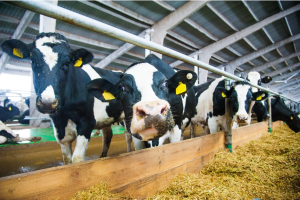
Written by: Guest | June 30, 2023
 By: Emma Bower, AFIA summer communications intern
By: Emma Bower, AFIA summer communications intern
When it comes to managing pre-consumer food waste, dairy cows are a huge part of the solution because, to them, these byproducts are a luxury. “These animals have specifically evolved to digest fiber and extract nutrition. The byproducts, for example—it’s good stuff for them; it has nutritive value,” said Juan Tricarico, Ph.D., senior vice president of environmental research and distinguished scientist at Dairy Management, Inc. (DMI), in a TIME article.
U.S. dairy cows utilize between 35.3 M tons and 45.2 M tons of byproduct feeds each year, as their digestive tracts are well suited to use highly fibrous agricultural byproducts, turning it into calories and protein. While it’s not common to feed post-consumer food scraps to ruminant animals, dairy farms can still play a role in solutions for this kind of food waste. Many dairy farms use cows’ manure alongside scraps and food waste in devices called anaerobic digesters.
Lori Captain, DMI’s executive vice president of global sustainability, explained that in anaerobic digesters, micro-organisms break down organic materials, capturing energy in a closed tank. Bacteria then break down the manure and food waste, creating biogas. This can be used to cycle energy back into the farm itself in the form of electricity, heat, compressed natural gas and vehicle fuels. Just like Kruse Western Renewable Fuels sources renewable natural gas (RNG) from California’s San Joaquin Valley dairies, which capture methane, greenhouse gas (GHG), and direct it away from the environment.
“When we think about the future of dairies, what’s exciting beyond lowering carbon footprint and improving air quality is the increased marketability of biofuels,” said Dan Rice, Western Milling’s quality assurance director.
Reinford Farms in Pennsylvania takes in about 35,000 tons of food waste annually working with more than 50 waste supplier clients including local grocery stores and restaurants. The farm also added a depackager machine into the mix. The farm now accepts more than traditional “compostable” foods (i.e., produce); it can convert liquid, semi-liquid and solid packaged foods into renewable energy, provide hot water for the property and creating fertilizer for crops.
“Since we added the depackager, we’ve recycled more than a million pounds of cardboard, more than a million pounds of tin cans and about 800,000 pounds of aluminum cans,” said Brett Reinford, partner, and president of Reinford Farms.
The dairy industry has also been focused on reducing methane. Cows emitting methane is a part of their digestive process, also known as “enteric” emissions, but Captain said the dairy sector has come a long way toward recognizing and addressing this through research of additives, supplements and genetic traits and research on the cow’s microbiome composition.
As for the methane that comes from food waste, feeding byproducts to dairy cows can lead to significantly fewer emissions than other methods of disposal. A DMI-commissioned that evaluated the impacts of using byproduct feed to sustain dairy cows shows that if you incinerate food waste, you only get energy. If you compost them, some of the nutrients that get recycled into the soil remain, but you will lose some to emissions, and landfills are the worst-case scenario because all nutrients are lost, in the end, giving it three potential uses.
“The bottom line is that dairy cattle consume substantial amounts and a wide variety of byproduct feed and are an effective vehicle to recycle valuable nutrients in agricultural byproduct streams that are either indigestible by humans or undesirable for direct human consumption,” says Tricarico.
Along with the DMI study, The Institute for Feed Research and Education (IFEEDER) started a project that will evaluate different dairy feed management strategies, including emerging feed additives. They aim to better inform greenhouse gas (GHG) mitigation strategies for cattle, NRCS programs and the development of protocols for measuring enteric emissions. This effort is led by The Nature Conservancy in support of U.S. Dairy’s Net Zero Initiative (NZI), partnering with Dairy Management, Inc. and IFEEDER.
Operating more sustainably has less tangible but equally impactful benefits—including a feel-good factor.
Comments See our policy on comments